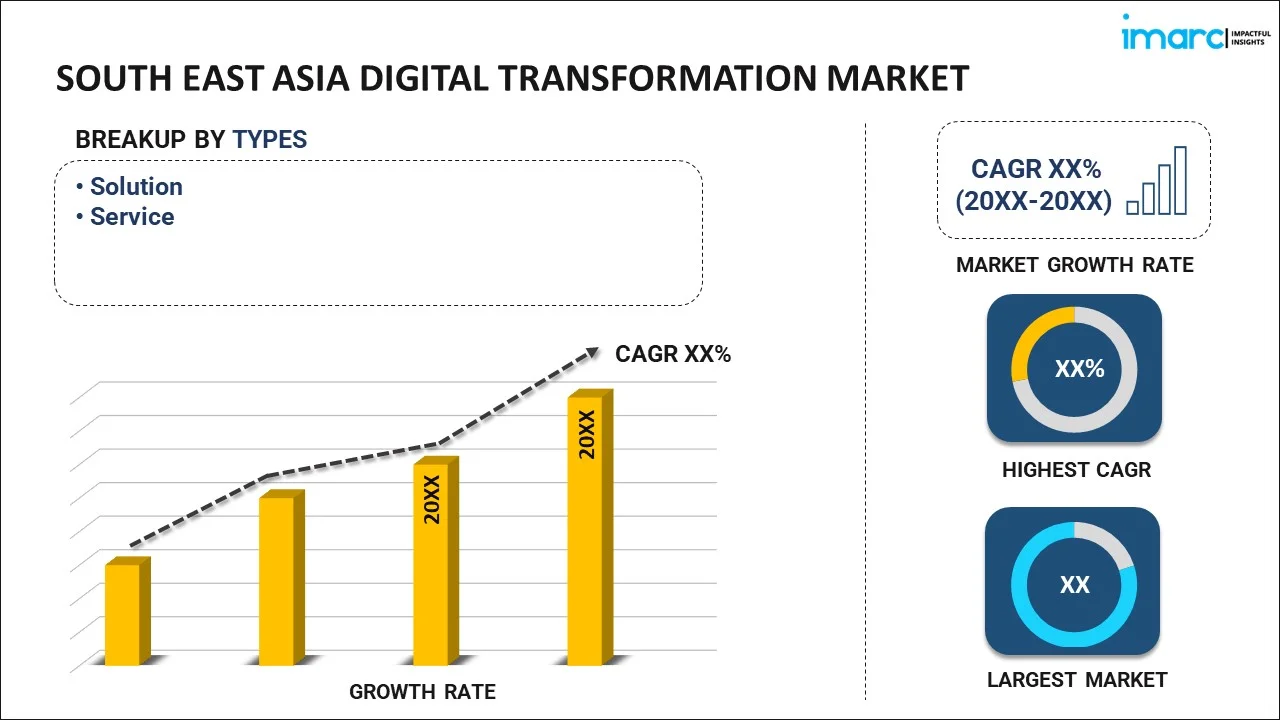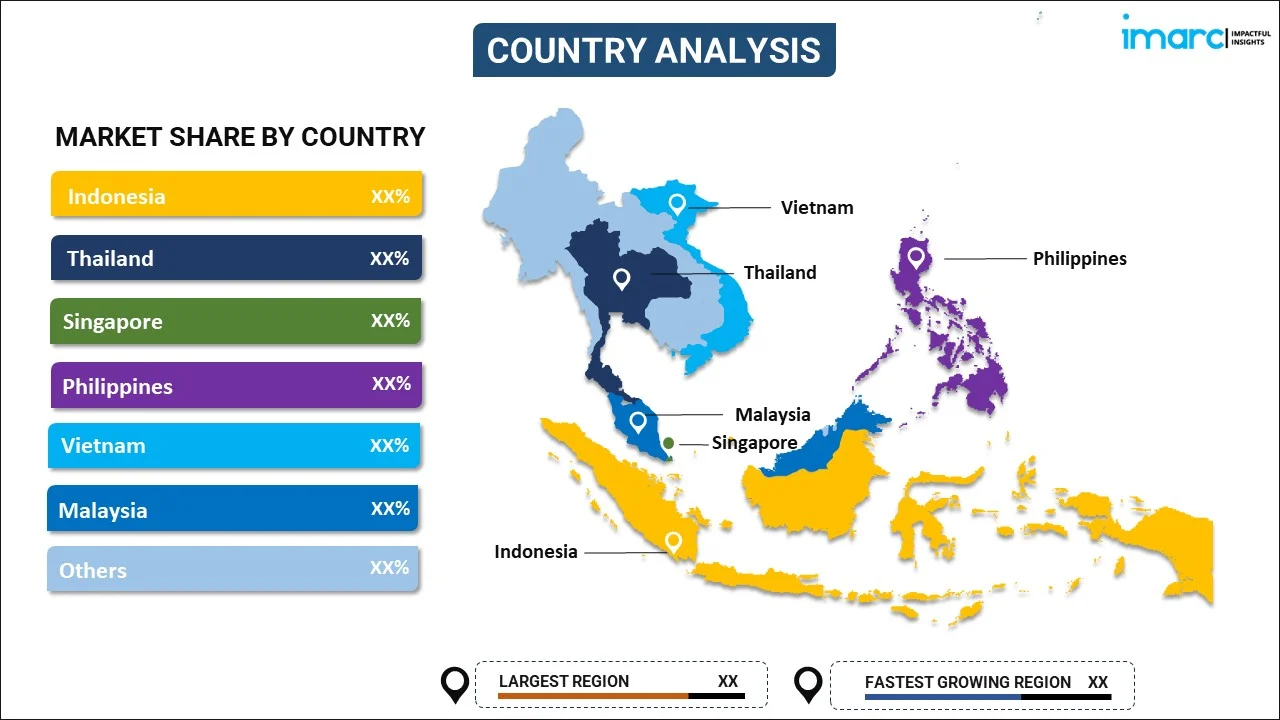
South East Asia Digital Transformation Market Report by Type (Solution, Service), Deployment Mode (Cloud-based, On-premises), Enterprise Size (Large Enterprises, Small and Medium-sized Enterprises), End Use Industry (BFSI, Manufacturing and Retail, Government, Healthcare, IT and Telecom, and Others), and Country 2025-2033
Market Overview:
South East Asia digital transformation market size is projected to exhibit a growth rate (CAGR) of 12.54% during 2025-2033. The increasing preference for wireless communication technologies and extensive research and development (R&D) initiatives are primarily driving the market growth.
|
Report Attribute
|
Key Statistics
|
|---|---|
|
Base Year
|
2024 |
|
Forecast Years
|
2025-2033
|
|
Historical Years
|
2019-2024
|
| Market Growth Rate (2025-2033) | 12.54% |
Digital transformation signifies a fundamental change in the culture of organizations, where the seamless incorporation of digital technologies revolutionizes diverse business procedures, enhancing an organization's reputation, customer experience, and customer retention rates. Among the leading-edge technologies involved in this process are 3D printing, robotics, artificial intelligence (AI), and additive manufacturing. This transformative strategy amplifies business efficiency and key capabilities by digitally optimizing operations. As a result, digital transformation has become widespread across various industries, including banking, financial services, insurance (BFSI), healthcare, retail, transportation, and information technology (IT). These sectors leverage the potential of digitalization to provide customized and tailored services to their esteemed clientele, solidifying their competitive advantage. By integrating digital technologies into various business functions, organizations can unlock new levels of productivity and efficacy.
South East Asia Digital Transformation Market Trends:
The South East Asia digital transformation market is primarily steered by the swift digitalization observed across the corporate landscape. With the continuous automation of multiple business procedures and the increasing adoption of remote working models, numerous small, medium, and large-scale enterprises are actively implementing digital transformation solutions to gain a competitive advantage, enhance customer engagements, and provide a seamless experience to their clientele. Additionally, the rising preference for online banking facilities, growing utilization of digital tools among small and medium-sized businesses (SMEs), and the expanding use of wireless communications to alleviate security apprehensions are acting as significant growth-inducing factors. This momentum is further reinforced by the ongoing technological advancements, including the growing integration of connected devices through the Internet of Things (IoT) and the widespread adoption of cloud computing solutions, which are fueling the growth of the market. Moreover, the introduction of industrial robots, alongside the emergence of Industry 5.0 aimed at bolstering the overall efficiency of smart factory systems, is anticipated to create a positive market outlook within the region over the forecasted period.
South East Asia Digital Transformation Market Segmentation:
IMARC Group provides an analysis of the key trends in each segment of the market, along with forecasts at the regional and country levels for 2025-2033. Our report has categorized the market based on type, deployment mode, enterprise size, and end use industry.
Type Insights:

- Solution
- Analytics
- Cloud Computing
- Mobility
- Social Media
- Others
- Service
- Professional Services
- Integration and Implementation
The report has provided a detailed breakup and analysis of the market based on the type. This includes solution (analytics, cloud computing, mobility, social media, and others) and service (professional services and integration and implementation).
Deployment Mode Insights:
- Cloud-based
- On-premises
A detailed breakup and analysis of the market based on the deployment mode have also been provided in the report. This includes cloud-based and on-premises.
Enterprise Size Insights:
- Large Enterprises
- Small and Medium-sized Enterprises
The report has provided a detailed breakup and analysis of the market based on the enterprise size. This includes large enterprises and small and medium-sized enterprises.
End Use Industry Insights:
- BFSI
- Manufacturing and Retail
- Government
- Healthcare
- IT and Telecom
- Others
A detailed breakup and analysis of the market based on the end use industry have also been provided in the report. This includes BFSI, manufacturing and retail, government, healthcare, IT and telecom, and others.
Country Insights:

- Indonesia
- Thailand
- Singapore
- Philippines
- Vietnam
- Malaysia
- Others
The report has also provided a comprehensive analysis of all the major regional markets, which include Indonesia, Thailand, Singapore, Philippines, Vietnam, Malaysia, and Others.
Competitive Landscape:
The market research report has also provided a comprehensive analysis of the competitive landscape. Competitive analysis such as market structure, key player positioning, top winning strategies, competitive dashboard, and company evaluation quadrant has been covered in the report. Also, detailed profiles of all major companies have been provided.
South East Asia Digital Transformation Market Report Coverage:
| Report Features | Details |
|---|---|
| Base Year of the Analysis | 2024 |
| Historical Period | 2019-2024 |
| Forecast Period | 2025-2033 |
| Units | Billion USD |
| Scope of the Report | Exploration of Historical and Forecast Trends, Industry Catalysts and Challenges, Segment-Wise Historical and Predictive Market Assessment:
|
| Types Covered |
|
| Deployment Modes Covered | Cloud-based, On-premises |
| Enterprise Sizes Covered | Large Enterprises, Small and Medium-sized Enterprises |
| End Use Industries Covered | BFSI, Manufacturing and Retail, Government, Healthcare, IT and Telecom, Others |
| Countries Covered | Indonesia, Thailand, Singapore, Philippines, Vietnam, Malaysia, Others |
| Customization Scope | 10% Free Customization |
| Post-Sale Analyst Support | 10-12 Weeks |
| Delivery Format | PDF and Excel through Email (We can also provide the editable version of the report in PPT/Word format on special request) |
Key Questions Answered in This Report:
- How has the South East Asia digital transformation market performed so far and how will it perform in the coming years?
- What has been the impact of COVID-19 on the South East Asia digital transformation market?
- What is the breakup of the South East Asia digital transformation market on the basis of type?
- What is the breakup of the South East Asia digital transformation market on the basis of deployment mode?
- What is the breakup of the South East Asia digital transformation market on the basis of enterprise size?
- What is the breakup of the South East Asia digital transformation market on the basis of end use industry?
- What are the various stages in the value chain of the South East Asia digital transformation market?
- What are the key driving factors and challenges in the South East Asia digital transformation?
- What is the structure of the South East Asia digital transformation market and who are the key players?
- What is the degree of competition in the South East Asia digital transformation market?
Key Benefits for Stakeholders:
- IMARC’s industry report offers a comprehensive quantitative analysis of various market segments, historical and current market trends, market forecasts, and dynamics of the South East Asia digital transformation market from 2019-2033.
- The research report provides the latest information on the market drivers, challenges, and opportunities in the South East Asia digital transformation market.
- Porter's five forces analysis assist stakeholders in assessing the impact of new entrants, competitive rivalry, supplier power, buyer power, and the threat of substitution. It helps stakeholders to analyze the level of competition within the South East Asia digital transformation industry and its attractiveness.
- Competitive landscape allows stakeholders to understand their competitive environment and provides an insight into the current positions of key players in the market.
Need more help?
- Speak to our experienced analysts for insights on the current market scenarios.
- Include additional segments and countries to customize the report as per your requirement.
- Gain an unparalleled competitive advantage in your domain by understanding how to utilize the report and positively impacting your operations and revenue.
- For further assistance, please connect with our analysts.
 Inquire Before Buying
Inquire Before Buying
 Speak to an Analyst
Speak to an Analyst
 Request Brochure
Request Brochure
 Request Customization
Request Customization




.webp)




.webp)












